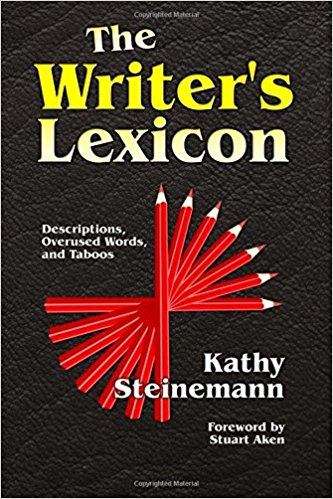In “The Art of Authorship,” Mark Twain famously stated, “The difference between the almost right word and the right word is really a large matter– ’tis the difference between the lightning bug and a lightning bolt.”
There’s a reason Twain is one of our most revered writers of all time. He was a true wordsmith.

For the rest of us who have to work a little harder to make our fiction and creative nonfiction cut through the darkness, help has arrived.
The book title is linked to Amazon and it’s not a spoiler to say this is a great resource for any writer looking to rub some words in her hands…
THE WRITER’S LEXICON: Descriptions, Overused Words, and Taboos by Kathy Steinemann, CreateSpace Independent Publishing Platform. 2017. 318 pages.
Looking for a writer’s resource that works triple-duty as a thesaurus, an editing manual, and an instructional manual rife with exercises and examples? Then you need this book.
THE WRITER’S LEXICON is completely user-friendly. You can read it cover-to-cover, taking time to work the exercises if you are relatively new to the writing craft. Or you can grab it, reference the Table of Contents, and use it as needed.
It would also  make a great textbook for a creative writing class. Having spent a career teaching CW, I could see using this book to teach valuable mini-lessons each day on craft alone. The exercises are designed to stimulate creativity.
make a great textbook for a creative writing class. Having spent a career teaching CW, I could see using this book to teach valuable mini-lessons each day on craft alone. The exercises are designed to stimulate creativity.
Another thing I really liked about this book is Steinemann’s use of humor. How-To books can be a bit tedious. Not this one.
Steinemann is a writer after my own heart. Her exercises and examples are similar in tone to those I constructed for my own students after finding regular teaching materials way too deadly to capture student imaginations.
BUT make no mistake–there is plenty here for the advanced writer as well. Many of us struggle to vary our use of tired action tags. She shrugged. He rolled his eyes. You get the idea.
Here’s where the book functions as a thesaurus. This resource offers both synonyms for these overused phrases as well as suggestions for crafting stronger sentences.
Another section in this book addresses punctuation pitfalls. One of my favorite chapters is on the use of exclamation points. I once had a colleague who taught Environmental Science. Every time the English department received an email from Ms. Pahsnooty, we counted the exclamation points she used. A short email might contain thirty-six exclamation points. Steinemann needs to send that woman this book!!!!! (Irony, people.)
There’s an excellent section on figurative language and sensory description–ever need a better way to describe environmental ambiance? That’s in here, too.
But, my absolute favorite section of this book is a bit personal. I am told I come from a long line of female cussers. Knowing my prediliction for swearing can be a turn-off for some readers, I am trying to reduce my use of swear words.
There is a mighty, meaty chapter on doing just that along with suggestions and exercises for changing up tired old curses for more innovative, descriptive language.
All in all, THE WRITER’S LEXICON is a gem that belongs on your writer’s bookshelf. And that’s no fox shibblettes.
Thanks for stopping by–XOXO,
Susan J. Anderson
Foxy Writer Chick
Thanks, Susan. xoxo
LikeLike
You’re welcome, Kathy!
LikeLike
You do credit to the work of Kathy Steinemann. I am certain I will devour ‘The Writer’s Lexicon’ when I lay my hands on it.
LikeLiked by 2 people
Thanks for stopping by, Anita!
LikeLiked by 2 people
Thanks Anita! It’s definitely worth a purchase!
LikeLiked by 1 person